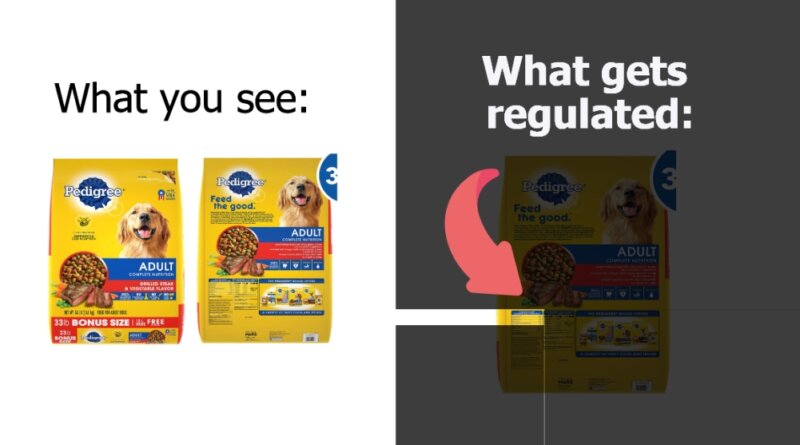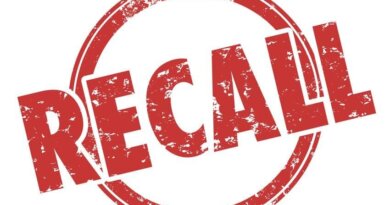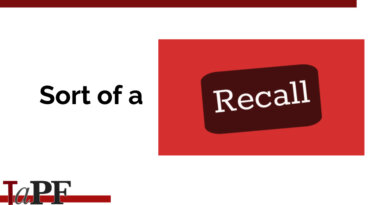What is Actually Regulated on Pet Food Labels? – Truth about Pet Food
Most information on pet food labels are marketing. As example, below is the front of a bag of dog food. The left side is what pet owners see, the right side is only the required information pet food manufacturers are required to include on labels.

The only required information on the above pet food label is the brand name (in the example: Pedigree), the product name (Grilled Steak & Vegetable Flavor), the nutritional adequacy statement (Adult Complete Nutrition), the species designation statement (Food for Adult Dogs), and the quantity statement (Net Wt 33 lb).
Everything else on the front of this bag of dog food is marketing. Unfortunately for pet food consumers, the marketing information is left up to the pet food manufacturers discretion. Regulatory authorities don’t take action against manufacturers for their marketing information on labels. Such as, this bag of pet food displays a picture of grilled steak…

…but this pet food does not contain grilled steak. The animal protein ingredients in this pet food are “meat and bone meal” and “chicken by-product meal“, ingredients that look exactly like this:

Unknowing pet owners see the marketing, especially the image of grilled steak on the label and do not know that most information on a pet food label is unregulated.
And the back of the label, below is what consumers see and by comparison the only required information monitored by regulatory authorities.

The lower left side of this bag of pet food contains the “Guaranteed Analysis“. The required by regulation information pet food manufacturers must guarantee is: minimum percentage of Crude Protein, minimum percentage of Crude Fat, the maximum percentage of Crude Fiber, and the maximum percentage of Moisture in the pet food. “Crude” implies the method of testing to determine the protein or fat or fiber content, it is a simplified method of testing. Regulatory authorities randomly test pet foods to validate the Guaranteed Analysis claims on labels, but – authorities typically only test for protein, fat and fiber (rarely test for fiber) – the required guarantees. Other guarantees made by manufacturers are rarely (if ever) validated by regulatory.

Under the Guaranteed Analysis is the Calorie Content. Most labels will state “calculated” meaning that the calorie content is determined by a math equation: 10 times the total of Crude Protein percentage times 3.5 plus Crude Fat percentage times 8.5 plus Carbohydrate/Fiber percentage times 3.5. The total provides “metabolizable energy (ME)” of the pet food.
Next on this label is the ingredient list. Ingredients are required to be listed in order of pre-cooking weight – heaviest to lightest.
And every pet food label is required to make a nutritional adequacy statement. This label states this dog food “Adult Complete Nutrition…is formulated to meet the nutritional levels established by the AAFCO Dog Food Nutrient Profiles for Maintenance.” The term “Maintenance” implies the required nutrients in the pet food are for adult animals. All pet foods are required to disclose if the food is “Complete” or for supplemental feeding. Complete (or Complete and Balanced) on the label means the pet food meets AAFCO nutrient profiles or the pet food has passed the AAFCO requirements for a feeding trial.
The “Nutrient Profile” pet foods are required to meet are decided by AAFCO (Association of American Feed Control Officials). AAFCO has determined the list of nutrients that are necessary for cats and dogs, and at what levels each nutrient must be. Most nutrients only have an established minimum, but no maximum. The profiles are provided by AAFCO “based on dry matter” – which calculates the nutrients without moisture considerations of ingredients/the pet food and “based on calorie content” (provided in a per 1,000 kcal format). AAFCO has two dog food nutrient profiles and two cat food nutrient profiles, one for “Growth (Puppy or Kitten) and Reproduction” and one for “Adult Maintenance“. Click Here to view a 2014 AAFCO document explaining the requirements of Nutrient Profiles. The only changes that have been made to these requirements since 2014 are for large breed puppy foods which require less maximum calcium. (AAFCO owns the Nutrient Profiles and they are not public information with the exception of documents AAFCO chooses to publish such as the 2014 document.)
Another requirement of pet food labels is feeding directions.

Unfortunately, even though feeding directions are required to be printed on the label – the exact directions are at the discretion of each manufacturer. As example a pet food could provide low amounts of recommended daily feeding to give the appearance the pet food is more affordable.
And then at the very bottom of this bag of pet food is the location for the Best by information, contact information for the manufacturer, and the UPC code.

Should a pet become ill from a pet food, the best by/best before information printed on the label is significantly important. Regulatory authorities need this information if they choose to investigate a health problem believed to be linked to the pet food. There is no uniform location for this information, pet owners often have to search (with a magnifying glass) for it. Often, the best by/best before and lot numbers are confused by pet owners with the UPC code (white box, lower right of image above) – but, the UPC code is not information regulatory authorities need.
Once a year pet food manufacturers are required to submit all of their product labels to state pet food regulatory authority. The regulatory authorities only check the labels to make sure the required information is printed on the label. This is what they visually check on the labels:

The only thing that – sometimes – gets actually validated by regulatory authorities on a pet food label is this:

What’s showing above is the first three items of the Guaranteed Analysis, crude protein, crude fat, and (very rarely) crude fiber. The ONLY thing pet food regulatory authorities validate – and that is only sometimes – is the stated information in the Guaranteed Analysis. That’s it.
Regulatory authorities do not regularly validate that the listed manufacturer actually manufactured the brand, they do not regularly validate the weight of the product, they do not regularly validate the pet food actually meets the claimed nutrient profile, they do not regularly validate the ingredients stated on the label are actually included in the pet food, and they do not validate that the recommended feeding directions adequately provide a pet with the proper levels of nutrients. AND…significantly, none of the marketing claims of any pet food is ever validated by regulatory authorities.
Personal Opinion: Pet Owners deserve far better than what we get from regulatory authorities. Regulatory often claims they have limited budgets and can’t do more, which could be true – but… Forty-two billion dollars of pet foods were sold in the US in 2020. Using an estimated 6% sales tax – this means that pet owners directly contributed to state government $2.52 billion dollars in revenue in 2020 alone. And what do we get in return for that $2.5 billion? Very random testing for crude protein and crude fiber. We deserve better.
Wishing you and your pet(s) the best,
Susan Thixton
Pet Food Safety Advocate
Author Buyer Beware, Co-Author Dinner PAWsible
TruthaboutPetFood.com
Association for Truth in Pet Food

Become a member of our pet food consumer Association. Association for Truth in Pet Food is a stakeholder organization representing the voice of pet food consumers at AAFCO and with FDA. Your membership helps representatives attend meetings and voice consumer concerns with regulatory authorities. Click Here to learn more.
What’s in Your Pet’s Food?
Is your dog or cat eating risk ingredients? Chinese imports? Petsumer Report tells the ‘rest of the story’ on over 5,000 cat foods, dog foods, and pet treats. 30 Day Satisfaction Guarantee. Click Here to preview Petsumer Report. www.PetsumerReport.com
Find Healthy Pet Foods in Your Area Click Here

The 2021 List
Susan’s List of pet foods trusted to give her own pets. Click Here to learn more.




